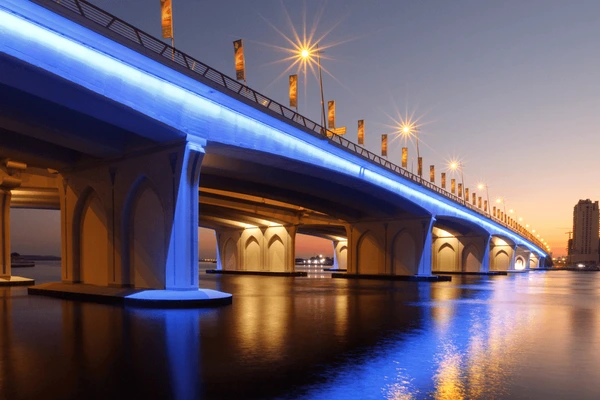Al Maktoum Bridge Dubai is one of the most important and iconic structures in the city, playing a critical role in the transportation network of Dubai. This bridge connects two key parts of the city, making it easier for thousands of commuters daily to travel across Dubai Creek smoothly. Whether you’re a resident, a tourist, or someone interested in Dubai’s infrastructure, understanding the significance of Al Maktoum Bridge Dubai is essential.
What is Al Maktoum Bridge Dubai?
Al Maktoum Bridge is a major road bridge spanning Dubai Creek, connecting the neighborhoods of Deira and Bur Dubai — two historically significant areas. Opened in 1963, it was Dubai’s first bridge over the creek, and it paved the way for modern transportation in the city.
Before the bridge was built, people relied mostly on traditional abra boats to cross the creek. The opening of Al Maktoum Bridge changed everything by allowing vehicles to pass between the two sides quickly and efficiently, dramatically improving connectivity.

Why is Al Maktoum Bridge Dubai Important?
The importance of Al Maktoum Bridge Dubai lies in its strategic location and the vital function it serves in easing traffic congestion. Dubai Creek divides the city, and without reliable crossing points, traveling between Bur Dubai and Deira would be time-consuming and inconvenient.
Key Reasons Why the Bridge Matters:
- Improved Connectivity: It links the commercial and residential areas of Bur Dubai and Deira.
- Traffic Flow: Helps divert heavy traffic from the older and crowded roadways.
- Economic Impact: Facilitates trade and business activities by ensuring smoother transportation routes.
- Cultural Significance: Being one of the oldest bridges, it represents Dubai’s growth from a small trading town to a global city.
History of Al Maktoum Bridge Dubai
Al Maktoum Bridge Dubai has an interesting history that reflects Dubai’s rapid development. The bridge was constructed in the early 1960s, a time when Dubai was transforming from a small fishing and pearl diving village to a bustling trading hub.

Construction and Early Days
- Opened: 1963
- Purpose: To replace the traditional water taxis (abras) and improve vehicle movement.
- Name: Named after the ruling Al Maktoum family, which continues to lead Dubai.
Initially, the bridge was a two-lane structure but has since been expanded to accommodate the growing traffic volume. Over the decades, the bridge has witnessed significant upgrades, ensuring it meets the needs of a fast-growing city.
Design and Structure
Al Maktoum Bridge Dubai is a straightforward yet functional design that focuses on durability and traffic efficiency. It stretches across Dubai Creek and is wide enough to carry multiple lanes of traffic in each direction.
Features of Al Maktoum Bridge:
- Length: Approximately 520 meters
- Lanes: Several lanes in both directions to manage heavy daily traffic.
- Connectivity: Connects major roads such as Al Mina Road and Al Khaleej Road.
- Safety Measures: Includes pedestrian walkways and lighting for night travel.
The bridge’s design balances functionality with the need to accommodate the continuous growth of Dubai’s population and traffic demands.
Role of Al Maktoum Bridge Dubai in Today’s Traffic System
Today, Al Maktoum Bridge Dubai remains one of the busiest crossings in the city. It serves thousands of vehicles every day, reducing the strain on other crossings like the Floating Bridge and the Business Bay Crossing.
Impact on Traffic:
- Reduces travel time across the creek.
- Diverts congestion from older routes.
- Supports public transport routes, including buses and taxis.
Dubai has also implemented smart traffic management systems around the bridge to keep traffic flowing smoothly during peak hours.
Comparison with Other Creek Crossings
Dubai Creek has several crossings now, including the Floating Bridge and Al Garhoud Bridge, but Al Maktoum Bridge remains essential because of its central location.
| Bridge Name | Year Opened | Location | Key Feature |
|---|---|---|---|
| Al Maktoum Bridge | 1963 | Bur Dubai – Deira | Oldest bridge, high traffic volume |
| Floating Bridge | 2007 | Near Al Maktoum Bridge | Temporary, toll-free crossing |
| Al Garhoud Bridge | 1976 | Near Dubai International Airport | Larger capacity, toll bridge |
Each bridge plays a specific role, but Al Maktoum Bridge’s strategic location continues to make it crucial for everyday commuters.
Challenges and Future Plans
Despite its importance, Al Maktoum Bridge Dubai faces some challenges, mainly due to the rapid increase in population and vehicles in Dubai. Congestion during peak hours can still be an issue.
Challenges:
- Increasing traffic demand.
- Aging infrastructure requiring maintenance.
- Limited space for expansion.
Future Development Plans:
Dubai’s authorities are continuously looking for ways to enhance traffic flow across the creek, including:
- Potential upgrades to the bridge infrastructure.
- Developing new road networks to complement the existing bridges.
- Encouraging public transport use to reduce vehicle numbers.
Smart city initiatives and innovative traffic management technologies are expected to support these goals in the coming years.

Experience and Views from Residents
Many Dubai residents rely on Al Maktoum Bridge daily for commuting to work, school, and other activities. The bridge is seen as a lifeline connecting important parts of the city.
Resident Opinions:
- Convenience: Most appreciate the quick crossing it offers compared to abra boats.
- Traffic: Some note congestion during rush hours but acknowledge its essential role.
- Sentiment: Many see it as a symbol of Dubai’s progress and modernization.
Visiting Al Maktoum Bridge Dubai: What to Know
If you’re visiting Dubai, Al Maktoum Bridge is more than just a transport route. It offers some scenic views of Dubai Creek and is near cultural hotspots in Bur Dubai and Deira.
Nearby Attractions:
- Gold Souk: Famous traditional market in Deira.
- Al Fahidi Historic District: Explore Dubai’s heritage near Bur Dubai.
- Dubai Creek: Take a boat ride to experience the city from the water.
Walking or driving across the bridge gives a unique perspective on the city’s blend of old and new.
Conclusion
Al Maktoum Bridge Dubai is much more than a simple road crossing — it is a crucial part of the city’s transportation backbone, a historical landmark, and a symbol of Dubai’s rapid growth. From its early days replacing water taxis to its role today managing thousands of vehicles, the bridge stands as a testament to Dubai’s forward-thinking urban planning.
Understanding Al Maktoum Bridge Dubai helps one appreciate how infrastructure shapes the daily lives of people and the development of a vibrant city. Whether for commuters, tourists, or history enthusiasts, the bridge remains an essential part of Dubai’s story.
Do follow UAE Stories on Instagram














